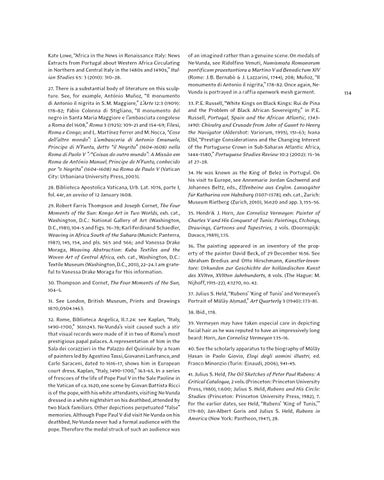Kate Lowe, “Africa in the News in Renaissance Italy: News Extracts from Portugal about Western Africa Circulating in Northern and Central Italy in the 1480s and 1490s,” Italian Studies 65: 3 (2010): 310–28. 27. There is a substantial body of literature on this sculpture. See, for example, António Muñoz, “Il monumento di Antonio il nigrita in S. M. Maggiore,” L’Arte 12:3 (1909): 178–82; Fabio Colonna di Stigliano, “Il monumento del negro in Santa Maria Maggiore e l’ambasciata congolese a Roma del 1608,” Roma 3 (1925): 109–21 and 154–69; Filesi, Roma e Congo; and L. Martínez Ferrer and M. Nocca, “Cose dell’altro mondo”: L’ambasceria di Antonio Emanuele, Principe di N’Funta, detto “il Negrita” (1604–1608) nella Roma di Paolo V ”/“Coisas do outro mundo”: A Missão em Roma de António Manuel, Principe de N’Funta, conhecido por “o Negrita” (1604–1608) na Roma de Paulo V (Vatican City: Urbaniana University Press, 2003). 28. Biblioteca Apostolica Vaticana, Urb. Lat. 1076, parte I, fol. 44r, an avviso of 12 January 1608. 29. Robert Farris Thompson and Joseph Cornet, The Four Moments of the Sun: Kongo Art in Two Worlds, exh. cat., Washington, D.C.: National Gallery of Art (Washington, D.C., 1981), 104–5 and figs. 76–78; Karl-Ferdinand Schaedler, Weaving in Africa South of the Sahara (Munich: Panterra, 1987), 145, 154, and pls. 565 and 566; and Vanessa Drake Moraga, Weaving Abstraction: Kuba Textiles and the Woven Art of Central Africa, exh. cat., Washington, D.C.: Textile Museum (Washington, D.C., 2011), 22–24. I am grateful to Vanessa Drake Moraga for this information. 30. Thompson and Cornet, The Four Moments of the Sun, 104–5. 31. See London, British Museum, Prints and Drawings 1870,0504.1463. 32. Rome, Biblioteca Angelica, II.7.24: see Kaplan, “Italy, 1490–1700,” 361n243. Ne-Vunda’s visit caused such a stir that visual records were made of it in two of Rome’s most prestigious papal palaces. A representation of him in the Sala dei corazzieri in the Palazzo del Quirinale by a team of painters led by Agostino Tassi, Giovanni Lanfranco, and Carlo Saraceni, dated to 1616–17, shows him in European court dress. Kaplan, “Italy, 1490–1700,” 163–65. In a series of frescoes of the life of Pope Paul V in the Sale Paoline in the Vatican of ca. 1620, one scene by Giovan Battista Ricci is of the pope, with his white attendants, visiting Ne-Vunda dressed in a white nightshirt on his deathbed, attended by two black familiars. Other depictions perpetuated “false” memories. Although Pope Paul V did visit Ne-Vunda on his deathbed, Ne-Vunda never had a formal audience with the pope. Therefore the medal struck of such an audience was
of an imagined rather than a genuine scene. On medals of Ne-Vunda, see Ridolfino Venuti, Numismata Romanorum pontificum praestantiora a Martino V ad Benedictum XIV (Rome: J. B. Bernabò & J. Lazzarini, 1744), 208; Muñoz, “Il monumento di Antonio il nigrita,” 178–82. Once again, NeVunda is portrayed in a raffia openwork mesh garment. 33. P. E. Russell, “White Kings on Black Kings: Rui de Pina and the Problem of Black African Sovereignty,” in P. E. Russell, Portugal, Spain and the African Atlantic, 1343– 1490: Chivalry and Crusade from John of Gaunt to Henry the Navigator (Aldershot: Variorum, 1995), 151–63; Ivana Elbl, “Prestige Considerations and the Changing Interest of the Portuguese Crown in Sub-Saharan Atlantic Africa, 1444–1580,” Portuguese Studies Review 10:2 (2002): 15–36 at 27–28. 34. He was known as the King of Belez in Portugul. On his visit to Europe, see Annemarie Jordan Gschwend and Johannes Beltz, eds., Elfenbeine aus Ceylon. Luxusgüter für Katharina von Habsburg (1507–1578), exh. cat., Zurich: Museum Rietberg (Zurich, 2010), 36n20 and app. 3, 155–56. 35. Hendrik J. Horn, Jan Cornelisz Vermeyen: Painter of Charles V and His Conquest of Tunis: Paintings, Etchings, Drawings, Cartoons and Tapestries, 2 vols. (Doornspijk: Davaco, 1989), 1:15. 36. The painting appeared in an inventory of the property of the painter David Beck, of 29 December 1656. See Abraham Bredius and Otto Hirschmann, Künstler-Inventare: Urkunden zur Geschichte der holländischen Kunst des XVIten, XVIIten Jahrhunderts, 8 vols. (The Hague: M. Nijhoff, 1915–22), 4:1270, no. 42. 37. Julius S. Held, “Rubens’ ‘King of Tunis’ and Vermeyen’s Portrait of Mulay Ahmad,” Art Quarterly 3 (1940): 173–81. 38. Ibid., 178. 39. Vermeyen may have taken especial care in depicting facial hair as he was reputed to have an impressively long beard: Horn, Jan Cornelisz Vermeyen 1:15–16. 40. See the scholarly apparatus to the biography of Mulay Hasan in Paolo Giovio, Elogi degli uomini illustri, ed. Franco Minonzio (Turin: Einaudi, 2006), 941–45. 41. Julius S. Held, The Oil Sketches of Peter Paul Rubens: A Critical Catalogue, 2 vols. (Princeton: Princeton University Press, 1980), 1:600; Julius S. Held, Rubens and His Circle: Studies (Princeton: Princeton University Press, 1982), 7. For the earlier dates, see Held, “Rubens’ ‘King of Tunis,’ ” 179–80; Jan-Albert Goris and Julius S. Held, Rubens in America (New York: Pantheon, 1947), 28.
114
